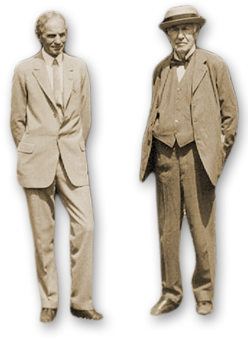The Reliance
August 15, 2022
By Matt Andres, Collections Registrar
As Thomas Edison raced from upriver toward his son Charles, shouts of, “We got a tarpon! We got a tarpon!” pierced the air. America’s favorite inventor was all smiles and began laughing wildly as he revealed his prize, a 40-pound tarpon captured from the depths of the Caloosahatchee River. Charles, who had stayed behind, unveiled another surprise, a 100-pound silver king (tarpon). Vanquished, Edison’s smile quickly turned to deflated disgust as he told his most trusted “mucker,” Freddie Ott, to throw his back overboard. Against Edison’s wishes, Ott refused and kept it – 118 years later, it hangs inside the Edison Ford museum. This all took place in 1904; Edison was a youthful 67 and Charles a mature 14 when the latter bested his father during their aquatic adventure. As if pouring salt water onto Mr. Edison’s wound, the Wizard’s son teased him for many years after this, reminding him on several occasions of his ultimate triumph.
It comes as no surprise that one of Edison’s favorite hobbies was fishing, where he made frequent bets with family members on the number and variety of fish caught during his excursions around Fort Myers. Initially fishing from his pier, Edison eventually spent some of his hard-earned money on a new toy – an electric launch. It gave Southwest Florida’s most famous resident unfettered access to new and even more remote waterways, which allowed him to explore its lush and pristine landscape, rich in wildlife and vegetation. As a result, boating quickly became another cherished pastime, with many hours spent out on the Caloosahatchee and beyond.
At a cost of $2,250.05, which was equivalent to four years pay for Edison’s caretaker, the Reliance, as it was named, was an impressive 36-foot electric vessel complete with wooden roof, canvas storm curtains, red, green, and white sailing lights, flag poles, and brass, brass, and more brass. Brass features included chocks, cleats, rowlocks, deck rails, and an air pump. The boat’s name could be seen glistening from afar as even this was spelled using brass lettering. Plush interior furnishings consisted of a divan seat, eight wicker chairs and table, brussels carpet, mahogany ladder, folding anchor, and a water closet with privacy curtains. A large whistle was installed and could be heard by all passersby. Yacht ensign and bow flag added an extra layer of respectability for the “Caloosahatchee’s Potamoi.”
Purchased from the Electric Launch Company based out of Bayonne City, New Jersey, it was initially shipped by truck to New York and later transported via the Clyde Steamship Line toward Jacksonville, Florida where it was placed on an Atlantic Coast Line Railway train bound for Punta Gorda. Upon its arrival, it was taken by steamer to Fort Myers, becoming the second vessel of Edison’s two-boat flotilla in 1904. It’s power source derived from rechargeable nickel iron alkaline batteries manufactured by the astute inventor and brought southward. Early on, Ott charged each battery using an old generator inside Edison’s original Fort Myers laboratory. Later, a newer onshore generator was installed that converted ac electricity from the city power grid to dc on Edison’s property. Staying true to his persona as master promoter, Edison would later boast of traveling over 100 miles on a fully charged series.
With a quick push of a button, many a good time were had navigating through Southwest Florida’s “boggy thoroughfares.” When not in use, it was housed inside a large boathouse (17’3” x 42’6”) situated alongside the pier’s pavilion. It was nearly destroyed in October 1910, when a horrendous hurricane made landfall near Fort Myers. It was described by Edison’s employee, Harvie Heitman, as “the most disastrous storm ever known to hit the city.” Approximately 200 feet of dock, as well as the boathouse storing Edison’s launch were swept away, pushing his vessel to parts unknown. It was eventually rescued by staff but sustained damage to its canopy, which was a total loss.
Another close call occurred in 1921 when stormy weather caused high tides, flooding, and rough seas. Ben Tinstman, Edison’s caretaker at the time, informed Mina Edison that the Reliance had broken loose and was set adrift. He later added that it nearly struck the city’s railroad dock downtown, but according to Tinstman, a Mr. Capling “at risk of his own life” saved it from complete destruction.
A couple of decades later, written evidence reveals that Henry Ford inquired about procuring the Reliance in hopes of displaying it inside his museum in Dearborn, Michigan. Unfortunately, the hurricane of 1944 obliterated Edison’s pier and with it his beloved launch. A letter sent to Ford in October 1944 mentioned, “Mr. Edison’s electric launch that you planned to take to Detroit was washed away and is down the beach about a mile a total wreck.”
Unsalvageable, it met an early demise amidst a watery grave. Today, a small replica model of Edison’s launch that embarked on a thousand fishing trips is on display within the “Fun in the Sun – Family & Friends” exhibit gallery inside the Edison Ford museum.


